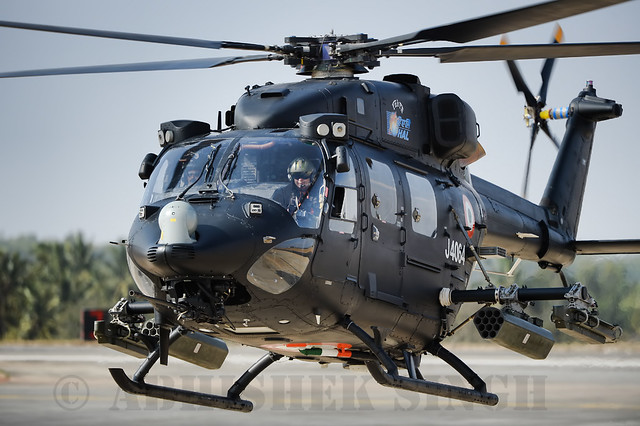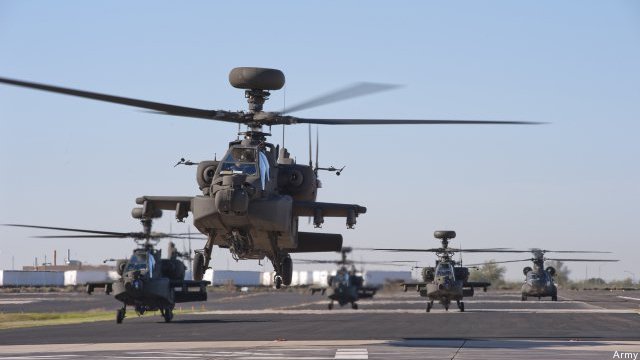Indian Army Aviation Corps grabs Apache gunships from IAF
The government has approved the raising of three squadrons of the iconic American-made Apache attack helicopters for the Indian Army. This marks a big win for the Army in its epic war with the Indian Air Force (IAF) for the control of helicopter gunships.
The Army will get 39 Apache attack helicopters at an estimated cost of over $2.5 billion after the first tranche of 22 of these gunships, currently being negotiated with the US, is delivered to the IAF disclosed an exultant officer at Army Headquarters.
All future acquisitions of attack helicopters will thereafter be for the Army, an indication that a reluctant IAF will gradually cede this role of providing close helicopter support for ground troops in combat entirely to the Army, which hopes to start getting its Apaches after 2018.
The new Apache squadrons will be integrated with three existing strike corps of the Army, which are tasked with an offensive cross-border role. This was a long-standing service requirement for a combined Army team concept explained the senior officer, arguing that an integrated attack helicopter element will mean better synergy with invading ground forces. Sources indicated that Apache elements will also be provided to the Mountain Strike Corps, which is in the process of being raised.
At the moment, India's Mi-35 and Mi-25 gunships are operated by the IAF under the command of the Army, which is now happier at the prospect of the Army Aviation Corps owning and flying the attack helicopters.
The Army's demand for integral attack helicopters gained currency after the Kargil War of 1999, where it clashed with the IAF in its insistence that helicopter gunships be used against Pakistani fighters entrenched on mountain tops. This even led to a stand-off between the then Chiefs of the Army and the IAF, General V.P. Malik and Air Chief Marshal A.Y. Tipnis.
The IAF's squadrons of heavy and slightly dated Mi-35 Russian-made gunships were not suited for operations at such heights as Kargil. Under pressure from the Army, the IAF used an Mi-17 transport helicopter as a makeshift gunship against the Pakistanis, who shot it down with a Stinger missile, inflicting both a setback and ignominy on the IAF.
The Army insisted on the use of attack helicopters. We kept asking them to tell us the task, and leave the choice of assets to be used to us recalls Air Marshal P.S. Ahluwalia, a former commander-in-chief of the Western Air Command. The IAF believes that the Army does not understand application of air power as well as a specialist Air Force would.
Also, it will take many years for the Army to operate the gunships independently, cautions Air Marshal Ahluwalia. It will take some time for Army pilots to be trained in fighter tactics and survivability he warns, shrugging that the process of training the Army in this role would have to be midwifed by the IAF. The slow-moving, low-flying attack helicopters are vulnerable to surface-to-air and air-to-air missile attacks.
The Army nibbling away at the Air Force turf has soured ties somewhat between the two forces, but observers believe that time is a healer. In the past, the IAF also strongly resisted relinquishing the maritime air role to the Navy, but today, naval aviation has matured into a potent specialist force operating everything from surveillance and anti-submarine warfare aircraft to contemporary multi-role fighters. The Navy's aviation arm has produced three chiefs in the last 25 years.
Having tasked blood with its success in wresting the attack helicopter role, the Army is now eyeing integral fixed-wing aircraft as well. Sensing further turf erosion, the IAF is reminding the Army that in the age of jointmanship and resource crunches, assets and roles must not be duplicated. The last word is yet to be said in the continuing inter-service rivalry.
The government has approved the raising of three squadrons of the iconic American-made Apache attack helicopters for the Indian Army. This marks a big win for the Army in its epic war with the Indian Air Force (IAF) for the control of helicopter gunships.
The Army will get 39 Apache attack helicopters at an estimated cost of over $2.5 billion after the first tranche of 22 of these gunships, currently being negotiated with the US, is delivered to the IAF disclosed an exultant officer at Army Headquarters.
All future acquisitions of attack helicopters will thereafter be for the Army, an indication that a reluctant IAF will gradually cede this role of providing close helicopter support for ground troops in combat entirely to the Army, which hopes to start getting its Apaches after 2018.
The new Apache squadrons will be integrated with three existing strike corps of the Army, which are tasked with an offensive cross-border role. This was a long-standing service requirement for a combined Army team concept explained the senior officer, arguing that an integrated attack helicopter element will mean better synergy with invading ground forces. Sources indicated that Apache elements will also be provided to the Mountain Strike Corps, which is in the process of being raised.
At the moment, India's Mi-35 and Mi-25 gunships are operated by the IAF under the command of the Army, which is now happier at the prospect of the Army Aviation Corps owning and flying the attack helicopters.
The Army's demand for integral attack helicopters gained currency after the Kargil War of 1999, where it clashed with the IAF in its insistence that helicopter gunships be used against Pakistani fighters entrenched on mountain tops. This even led to a stand-off between the then Chiefs of the Army and the IAF, General V.P. Malik and Air Chief Marshal A.Y. Tipnis.
The IAF's squadrons of heavy and slightly dated Mi-35 Russian-made gunships were not suited for operations at such heights as Kargil. Under pressure from the Army, the IAF used an Mi-17 transport helicopter as a makeshift gunship against the Pakistanis, who shot it down with a Stinger missile, inflicting both a setback and ignominy on the IAF.
The Army insisted on the use of attack helicopters. We kept asking them to tell us the task, and leave the choice of assets to be used to us recalls Air Marshal P.S. Ahluwalia, a former commander-in-chief of the Western Air Command. The IAF believes that the Army does not understand application of air power as well as a specialist Air Force would.
Also, it will take many years for the Army to operate the gunships independently, cautions Air Marshal Ahluwalia. It will take some time for Army pilots to be trained in fighter tactics and survivability he warns, shrugging that the process of training the Army in this role would have to be midwifed by the IAF. The slow-moving, low-flying attack helicopters are vulnerable to surface-to-air and air-to-air missile attacks.
The Army nibbling away at the Air Force turf has soured ties somewhat between the two forces, but observers believe that time is a healer. In the past, the IAF also strongly resisted relinquishing the maritime air role to the Navy, but today, naval aviation has matured into a potent specialist force operating everything from surveillance and anti-submarine warfare aircraft to contemporary multi-role fighters. The Navy's aviation arm has produced three chiefs in the last 25 years.
Having tasked blood with its success in wresting the attack helicopter role, the Army is now eyeing integral fixed-wing aircraft as well. Sensing further turf erosion, the IAF is reminding the Army that in the age of jointmanship and resource crunches, assets and roles must not be duplicated. The last word is yet to be said in the continuing inter-service rivalry.
















